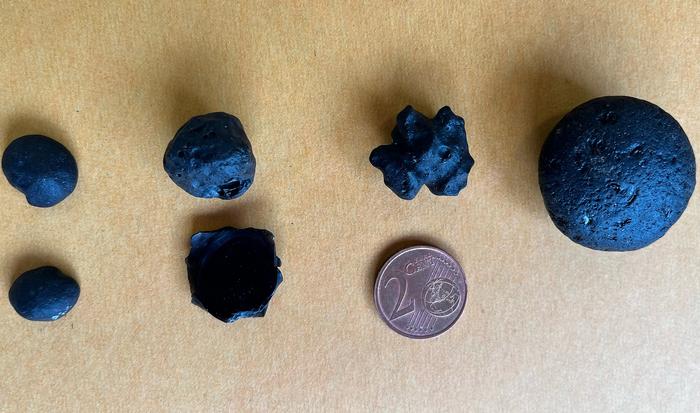Back to Article List
A new study re-evaluating Australian tektites uncovers a previously unrecognized cosmic collision that occurred 11 million years ago.

Tektites, or “cosmic glass,” are natural glasses formed when an asteroid strikes Earth. These specimens, which are about 11 million years old, were found to belong to a new type of tektite found only in South Australia. Credit: Earth and Planetary Science Letters
Tiny pieces of glass found scattered across Australia have revealed evidence of a previously unknown giant asteroid impact.
This discovery centers on a new type of tektite, a natural glass formed when a space rock slams into Earth, melting surface material and scattering debris. The new tektites, which the authors have named “ananguites,” were found exclusively in parts of South Australia. Distinct in composition and age from all other known tektites, ananguites are evidence of an ancient impact event that was previously unknown.
“Finding a new tektite field is like opening a fresh chapter in Earth’s violent geological past,” said study co-author Fred Jourdan, a geochronologist and geochemist at Curtin University in Perth, in a press release. “What makes the discovery even more intriguing is that, although the impact must have been immense, scientists are yet to locate the crater.” What’s more, the large area across which the ananguite samples were found suggests the crater, yet to be discovered, must be quite large.
The results were published Sept. 17, 2025, in Earth and Planetary Science Letters.
The evidence
Tektites are a fascinating byproduct of planetary impacts. Created in an instant, they are pieces of melted Earth rock (with just a bit of contamination from the impactor) that can be ejected thousands of miles from the impact site. Their study provides a crucial record of our planet’s ancient collisions.
Australia is no stranger to tektites, as it lies in the famous Australasian tektite field — the largest and youngest known tektite strewn field on Earth. Formed approximately 780,000 years ago, it stretches across half the globe, from southern China to Antarctica.
But the new group of Australian tektites, reported by a team led by Anna Musolino of Aix-Marseille University in France, have an age of approximately 11 million years. This makes them a geological time capsule from a completely separate event.
The team’s analysis showed the new tektites have a distinct chemistry characterized by a very high ratio of sodium to potassium. Their makeup of isotopes — elements with the same number of protons but varying numbers of neutrons — was also unique. Unlike the Australasian tektites, which formed from rocks of the ancient continental crust, the ananguites’ isotopic data suggest they originated from younger volcanic rocks.
Researchers also found high levels of nickel and chromium — elements common in chondritic meteorites — which provided a chemical fingerprint of the impactor.
Sizing it up
The new strewn field is an approximately 560-mile-long (900 kilometers) ellipse. Though much smaller than the Australasian field, it still suggests an immense source crater. By comparison, the tektites from the Ries crater in Germany, about 16 miles (26 km) in diameter, are scattered over a strewn field of about 190 miles (300 km). The much larger size of the Australian strewn field suggests its source crater is likely to be significantly larger than 16 miles.
Jourdan said the significance of the find extends beyond its historic value. “Understanding when and how often large asteroids have struck Earth also helps us assess the risk of future impacts, which is important for planetary defence.”
